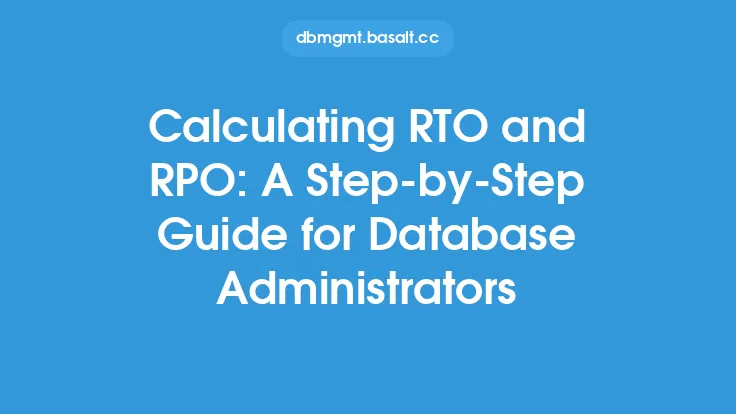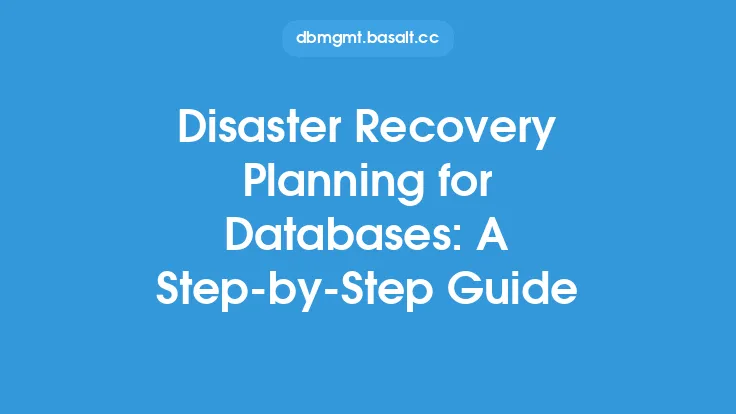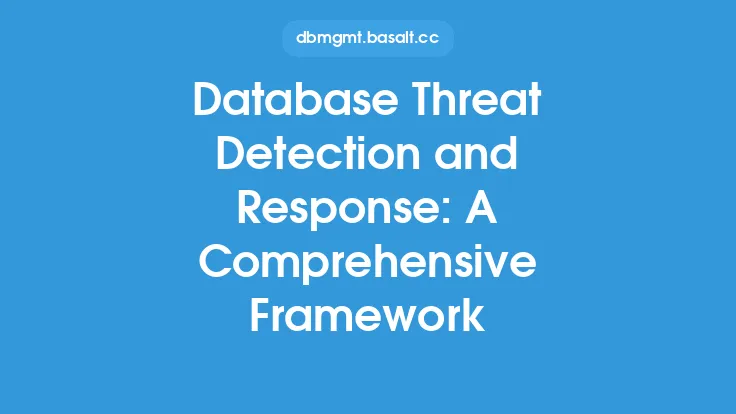When it comes to database backup and recovery, two crucial metrics that database administrators and organizations must consider are Recovery Time Objective (RTO) and Recovery Point Objective (RPO). These metrics are essential in ensuring that databases can be restored to a functional state in the event of a disaster or data loss, minimizing downtime and data loss. In this article, we will delve into the world of RTO and RPO planning for databases, providing a comprehensive framework for success.
Introduction to RTO and RPO Planning
RTO and RPO planning is a critical aspect of database management, as it enables organizations to establish clear goals and objectives for database recovery. RTO refers to the maximum amount of time that an organization can tolerate a database being offline or unavailable, while RPO refers to the maximum amount of data that can be lost in the event of a disaster. By establishing clear RTO and RPO objectives, organizations can ensure that their databases are backed up and recovered in a timely and efficient manner, minimizing the risk of data loss and downtime.
Assessing Database Requirements
To develop an effective RTO and RPO plan, organizations must first assess their database requirements. This involves identifying the criticality of each database, as well as the potential impact of downtime or data loss on the business. Organizations should consider factors such as the type of data stored in the database, the frequency of transactions, and the potential consequences of data loss or corruption. By understanding these requirements, organizations can establish realistic RTO and RPO objectives that balance the need for data protection with the need for system availability.
Developing an RTO and RPO Plan
Once the database requirements have been assessed, organizations can develop an RTO and RPO plan. This plan should include the following components:
- A clear definition of the RTO and RPO objectives for each database
- A description of the backup and recovery procedures to be used
- A schedule for backups and recoveries
- A plan for testing and validating backups
- A plan for restoring databases in the event of a disaster
- A plan for monitoring and reporting on database availability and performance
By including these components, organizations can ensure that their RTO and RPO plan is comprehensive and effective.
Implementing Backup and Recovery Procedures
The implementation of backup and recovery procedures is a critical aspect of RTO and RPO planning. Organizations should consider using a combination of backup methods, such as full backups, incremental backups, and transaction log backups, to ensure that databases are properly protected. Additionally, organizations should implement a recovery procedure that includes the use of backup tapes, disk-to-disk backups, or other storage media to restore databases in the event of a disaster. The choice of backup and recovery procedure will depend on the specific requirements of the database, as well as the resources available to the organization.
Testing and Validating Backups
Testing and validating backups is an essential step in the RTO and RPO planning process. Organizations should regularly test their backups to ensure that they are complete and can be restored in a timely manner. This can be done by performing a restore of a backup to a test environment, and verifying that the data is accurate and complete. By testing and validating backups, organizations can ensure that their RTO and RPO objectives are met, and that databases can be restored in the event of a disaster.
Monitoring and Reporting on Database Availability and Performance
Monitoring and reporting on database availability and performance is critical to ensuring that RTO and RPO objectives are met. Organizations should implement a monitoring system that tracks database availability, performance, and backup success. This information should be reported to stakeholders on a regular basis, to ensure that everyone is aware of the status of the databases. By monitoring and reporting on database availability and performance, organizations can quickly identify and respond to any issues that may arise, minimizing the risk of downtime and data loss.
Common Challenges and Solutions
Despite the importance of RTO and RPO planning, many organizations face challenges in implementing effective plans. Some common challenges include:
- Limited resources: Many organizations have limited resources, including budget, personnel, and infrastructure, which can make it difficult to implement effective RTO and RPO plans.
- Complexity: Database environments can be complex, with multiple databases, servers, and storage systems, which can make it difficult to develop and implement effective RTO and RPO plans.
- Lack of expertise: Many organizations lack the expertise and knowledge required to develop and implement effective RTO and RPO plans.
To overcome these challenges, organizations can consider the following solutions:
- Outsourcing: Organizations can outsource their RTO and RPO planning to a third-party provider, which can provide the necessary expertise and resources.
- Automation: Organizations can automate their backup and recovery procedures, which can simplify the process and reduce the risk of human error.
- Training: Organizations can provide training to their personnel, which can help to build the necessary expertise and knowledge.
Best Practices for RTO and RPO Planning
To ensure the success of RTO and RPO planning, organizations should follow best practices. Some best practices include:
- Establishing clear RTO and RPO objectives
- Developing a comprehensive RTO and RPO plan
- Implementing regular backup and recovery procedures
- Testing and validating backups
- Monitoring and reporting on database availability and performance
- Continuously reviewing and updating the RTO and RPO plan
By following these best practices, organizations can ensure that their RTO and RPO plan is effective, and that their databases are properly protected.
Conclusion
RTO and RPO planning is a critical aspect of database management, as it enables organizations to establish clear goals and objectives for database recovery. By assessing database requirements, developing an RTO and RPO plan, implementing backup and recovery procedures, testing and validating backups, monitoring and reporting on database availability and performance, and following best practices, organizations can ensure that their databases are properly protected, and that downtime and data loss are minimized. Whether you are a database administrator, IT manager, or business leader, understanding the importance of RTO and RPO planning, and implementing a comprehensive plan, is essential to ensuring the availability and integrity of your organization's databases.





